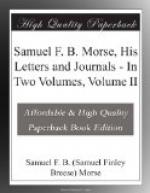There were twenty of these wonderful floral decorations on the pavement of one street and fourteen on that of the other and all are described in the notes, but I have particularized enough to show their character. The journal continues:—
“All these figures were as elegantly executed as if made for permanency, some with a minuteness truly astonishing. Among other decorations of the day was the free-will offering of one of the people who had it displayed at the side of his shop on a rude pedestal. It was called the ’Flight into Egypt,’ and represented Joseph and Mary and the infant on an ass, and all composed of shrubs and flowers. It was, indeed, a most ludicrous-looking affair; Joseph with a face (if such it might be called) of purple flowers and a flaxen wig, dressed in a coarse pilgrim’s cape studded over with yellow flowers, was leading by a hay band a green donkey, made of a kind of heath grass, with a tail of lavender and hoofs of cabbage leaves. Of this latter composition were also the sandals of Mary, whose face, as well as that of the bambino, was also of purple flowers and shapeless. The frock of the infant was of the gaudiest red poppy. It excited the laughter of almost all who saw it, except now and then some of the ignorant lower classes would touch their hats, cross themselves, and mumble a prayer.”
After describing some of the picturesque costumes of the contadini, he continues:—
“It was nearly dark before the procession, to which all these preparations had reference, began to move. At length the band of music was heard at the lower end of one of the streets, and a man, in ample robes of scarlet and blue, with a staff, was seen leading the procession, which need be no further described than to say it consisted of the usual quantity of monks chanting, with wax-tapers in their hands, crosses, and heavy, unwieldy banners which endanger the heads of the multitude as they pass; of a fine band of music playing beautiful waltzes and other compositions, and a quantum suff. of men dressed in the garb of soldiers to keep the good people uncovered and on their knees.
“The head of the procession had arrived at the top of the street when— crack! pop!—went forty or fifty crackers, which had been placed against the walls of a house near us, and which added wonderfully to the solemnity of the scene, and, accordingly, were repeated every few seconds, forming a fine accompaniment to the waltzes and the chanting of the monks. In a few minutes all the beauty of the flower-carpeted street was trodden out, and the last of the procession had hardly passed before all the flowers disappeared from the pillars, and all was ruin and disorder.
“The procession halted at a temporary altar at the top of the street, and we set out on our return at the same moment down the street, facing the immense multitude which filled the whole street. We had scarcely proceeded a third of the distance down when we suddenly saw all before us uncovered and upon their knees. We alone formed an exception, and we continued our course with various hints from those around us to stop and kneel, which we answered by talking English to each other in a louder tone, and so passed for unchristian forestieri, and escaped unmolested, especially as the soldiers were all at the head of the street.




